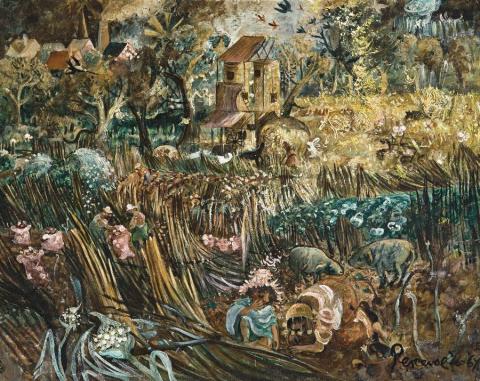WHEATFIELD AND POTATO DIGGERS, 1947-67
JOHN PERCEVAL
tempera, resin and oil on canvas on composition board
75.0 x 94.0 cm
signed and dated lower right: Perceval ‘46 [sic] - ‘67
signed, dated and inscribed verso: Wheatfield [sic] & Potatoe [sic] Diggers’ / Perceval 47-67
label verso: ‘Wheat-field [sic] & Potatoe [sic] Diggers’ / 1947 - 67
South Yarra Gallery, Melbourne (label attached verso)
M.M. and R.B. Hume, Macedon, Victoria
Thence by descent
Private collection, Melbourne
Deutscher~Menzies, Melbourne, 28 November 2001, lot 32
Private collection, Melbourne
John Perceval, South Yarra Gallery, Melbourne, 17 April 1968, cat. 18
Aspects of the Work of John Perceval 1947–1968, Clune Galleries, Sydney, 12 November 1968, cat. 5 (detail illus., lent by Mr and Mrs R.B. Hume)
Plant, M., John Perceval, Lansdowne Press, Melbourne, 1971, dust jacket, p. 24 (illus.)
Gleeson, J., Masterpieces of Australian Painting, Lansdowne Press, Melbourne, 1969, p. 153, pl. 61 (illus.)
Gleeson, J., Modern Painters 1931–1970, Lansdowne Press, Melbourne, 1977, pp. 94–95, pl. 39 (illus.)
Allen, T., John Perceval, Melbourne University Press, Melbourne, 1992, p. 151
John Perceval's Wheatfield and Potato Diggers draws richly on a number of European masters to produce a painting that is strikingly individual. Full of Hogarthian humour and Brueghelian incident, it pulsates with the life force of a Van Gogh. In the latter half of the 1940s, with an increasing interest in quality craftsmanship, Perceval looked to the work of a number of Old Masters as a certain guide in sound technique and materials of lasting quality. Chief among these were Pieter Brueghel the Elder, Hieronymous Bosch, Rembrandt, Hogarth, Tintoretto and El Greco. In Perceval's Nativity I 1947, for example, the compositional debt is to Tintoretto and his painting of the same subject in Venice's Scuolo di San Rocco. Perceval also liked to use the high viewpoint and panoramic spread that characterise so much of Brueghel's art. Locations, however, were decidedly Australian, or more particularly Melbournian. In his 1948 painting Christ Dining at Young and Jackson's, for example, Perceval set the Biblical story of Christ dining with the publicans and sinners in Melbourne's most iconic pub, complete with another local icon, the nineteenth century French painting of the nude Chloe. Wheatfield and Potato Diggers is likewise local in setting. When these genre and religious paintings were first exhibited in 1948, noted Melbourne academic Franz Phillip wrote in the catalogue introduction, 'The daily scene becomes imbued with the fantastic and turns into a fairy tale. The artist sets out to depict a Melbourne suburban scene but finally leaves us amongst the luminous turbulence of carnival merriment.'1
It was a wonderfully fruitful time for Perceval, resulting in the production of some of his finest work. His paintings pulsate with life, their restless activity continued through the lively brushstrokes and vivid colours of such engaging paintings as The Market Place and The Revellers, both of 1948. There is also a closeness about these paintings, motifs from one reappearing in another, as the tall barn with half a roof in the painting on offer being found in Christmas Eve 1948, which is set in a local bayside suburb. A robust and satiric humour permeates these busy works. In Wheatfield and Potato Diggers a mother and her small child occupy the foreground with two pigs. In a field of abundance, all grub in the ground for food.
In her monograph on Perceval, Margaret Plant, writes of our paintings dual dates. 'One painting joins two periods of the artist's work. First begun in the mid forties, Wheatfield and Potato Diggers lay under a friend's bed for many years, until in 1968 it was completed. It has the best features of the familiar habitable landscape of the forties - the birds and the unfinished barns of the painting Christmas Eve - while behind the farmers and their animals is a patch of golden wheat.'2 This reworking is not unique in Perceval's oeuvre, being a confirmation of his high regard for these paintings. While preparing for his 1968 exhibition at the South Yarra Gallery, Perceval probably retouched some of the areas of lost paint, adding the later date in acknowledgement of the additions. Wheatfield and Potato Diggers and related works of the late forties together with the Gaffney's Creek and Williamstown paintings of 1956/1959 are among Perceval best works. The earlier works vibrate with humanity and humour, singling them out as something very special in Australian art.
1. Phillip, F., catalogue introduction, The Paintings of John Perceval, Book Club, Melbourne, 1948
2. Plant, M., John Perceval, Lansdowne Press, Melbourne, 1971, pp. 46, 50
DAVID THOMAS
